- Geopolitical tensions triggered the largest digital asset deleveraging event on record, resulting in approximately $19 bn in liquidations across all assets and more than $24.9 bn in open interest reductions among major assets.
- Bitcoin displayed notable resilience through the drawdown, while the altcoin sector sustained significantly deeper losses, resulting in the 12th largest single-day rise in Bitcoin dominance on record. This divergence underscores the growing disparity in demand and liquidity depth between Bitcoin and the broader altcoin market.
- Constructively, Bitcoin continues to defend its Short-Term Holder Cost-Basis (STH-CB), a key structural support for market stability. Sustaining this level could underpin price recovery, whereas a breakdown may signal renewed downside pressure and rising unrealised losses.
A Headline Driven Market
On Friday, October 10th, escalating geopolitical tensions between the United States and China rattled global markets. The pressure mounted after U.S President Donald Trump accused China of increasingly hostile behaviour on social media, stoking fears of a renewed deterioration in U.S.–China relations.
The surge in geopolitical hostility triggered a sharp rise in global uncertainty, sparking a market-wide flight from risk. Major equity indices, including the S&P 500 and the NASDAQ sold off sharply alongside digital assets, reflecting the depth of investor anxiety. This synchronous decline across both traditional and digital markets served as a stark reminder to the headline dominant nature of our current market regime, with negative news resulting in a rapid draining of liquidity from risk exposures worldwide.
The situation intensified after President Trump threatened to impose a 100% tariff on China's rare earth metal exports, critical inputs across numerous high-tech and defense industries. The digital asset market, being the only market open and readily available to trade, diverged meaningfully from their traditional counterparts, undergoing the most severe deleveraging event in their history. In this report, we examine this unprecedented leverage unwind by analysing the severity of the drawdown, the underlying catalysts that precipitated it, and the evolving market dynamics as the dust begins to settle.
A Digital Asset Fire Sale
When focusing on a composite basket of blue-chip digital assets, including Bitcoin, Ethereum, Solana, XRP, and Dogecoin, the major assets saw its combined market capitalization shrink by approximately $480 bn within a matter of hours. Nominally, this ranks as one of the sharpest duation events on record, underscoring both the magnitude and velocity of the market's capitulation.
Top Asset Market Cap
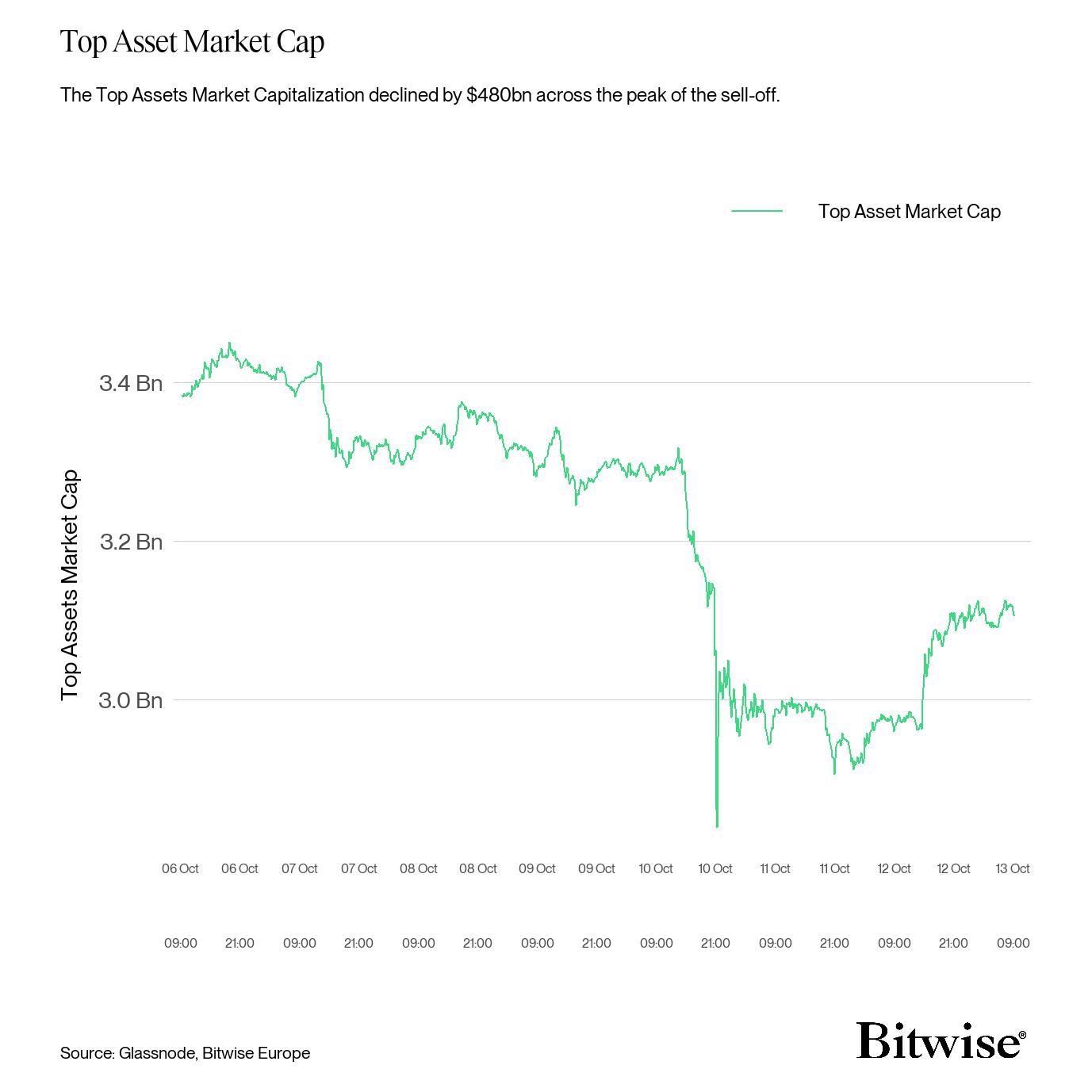
When examining the depth of the drawdowns experienced by each of the previously mentioned tokens during the correction period, we note that Bitcoin displayed markedly stronger resilience than its altcoin peers.
One explanation for Bitcoin's relative outperformance lies in its larger market capitalization, deeper liquidity, and sustained investor demand, all of which appear to have acted as a shock absorber during the market dislocation. These structural advantages helped insulate Bitcoin from the full extent of the broader downturn, reflecting its position as the most liquid and institutionally integrated asset within the digital asset ecosystem.
Alternatively, the major altcoins suffered much sharper drawdowns, with Dogecoin and XRP experiencing the heaviest pullbacks.
- Bitcoin experienced a peak drawdown of -11.5%, recovering to a-6.5% decline.
- Ethereum saw a maximum drawdown of -18.2%, rebounding to -10.3%.
- XRP recorded a steep -35.8% drawdown, recovering to -11.8%.
- Solana declined by -22.7% at its lowest point, improving to -12.8%.
- Dogecoin faced the sharpest pullback at -47.8%, recovering to -21.3%.
Top Asset Drawdowns
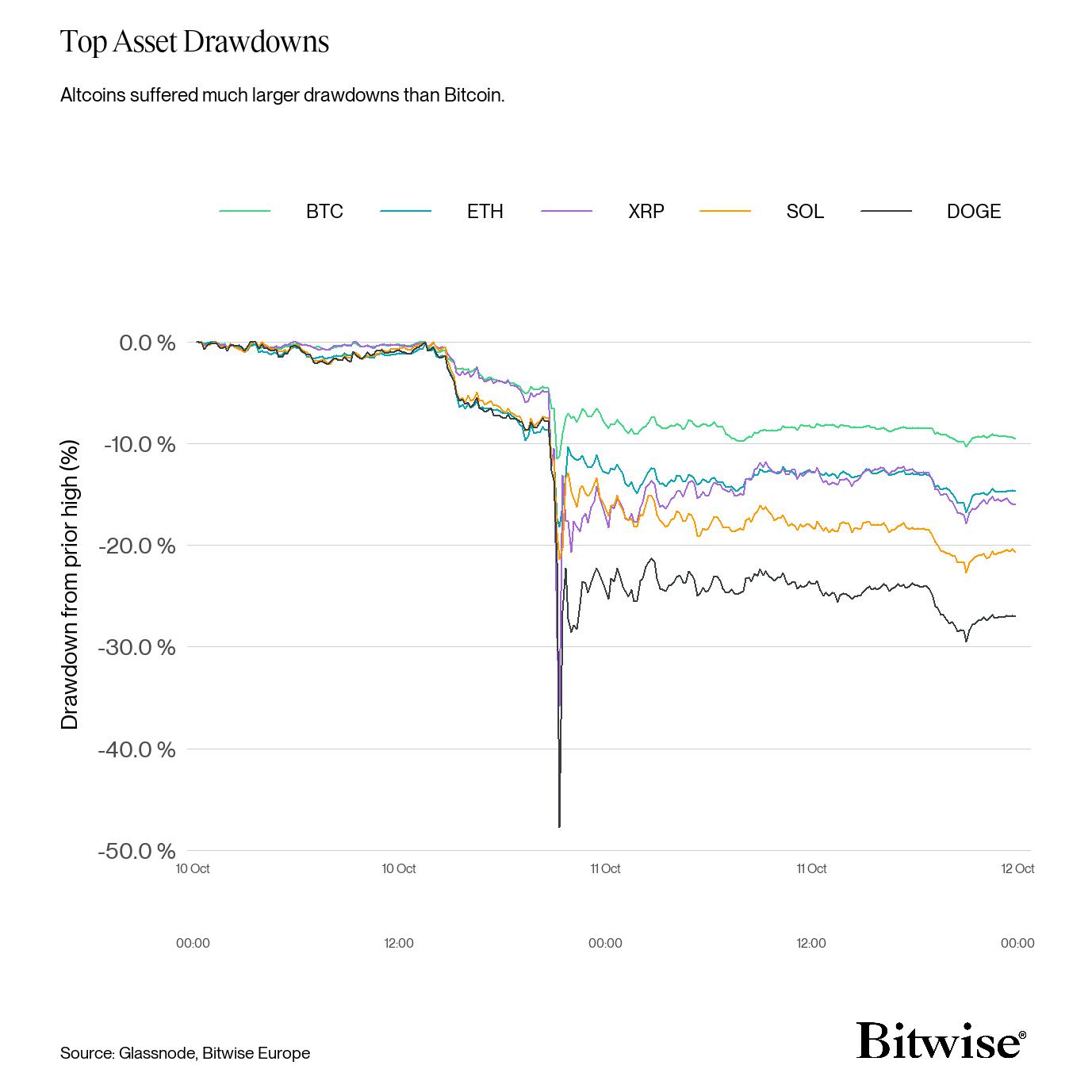
Bitcoin's resilience can be further evidenced by the Bitcoin dominance metric, which provides a quantitative validation of its relative strength during the sell-off. As the broader digital asset market contracted sharply, Bitcoin's market share increased materially, marking its 12th largest single-day rise in dominance on record, and the 6th largest to occur during an overall market contraction.
This outcome reflects Bitcoin's stronger demand profile and its structural inertia, reinforcing Bitcoin's position as the anchor asset of the digital asset ecosystem, particularly during periods of heightened market stress.
Bitcoin Dominance
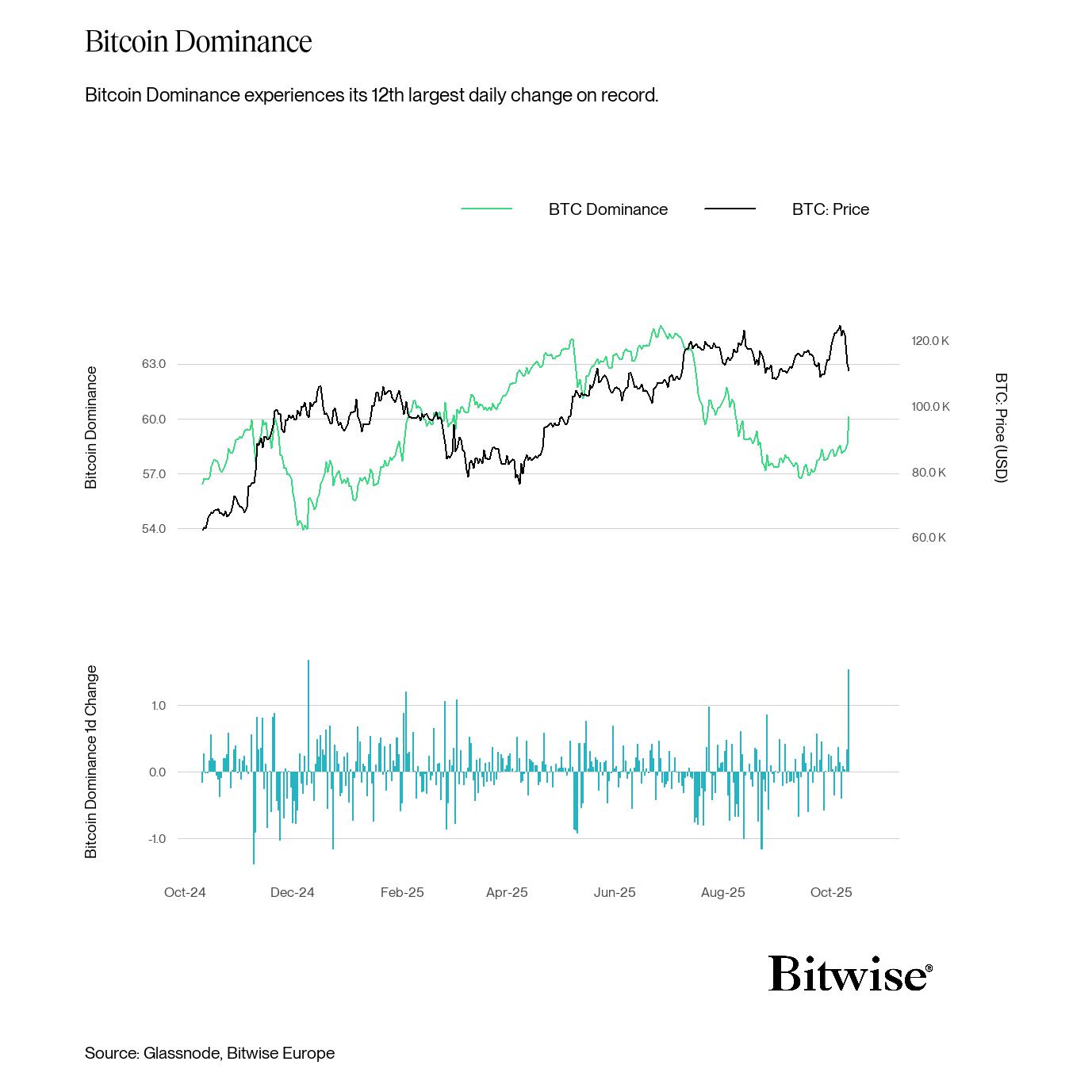
All Eyes on Altcoins
Having established that the altcoin sector has shouldered the majority of the economic pain throughout the recent decline, we now turn our focus to the realized losses incurred by investors of these assets during this contraction. By examining these losses on-chain, we can observe how investors reacted in real time to the event, providing insight into the level of stress and capitulation expressed across the market.
- Ethereum Realized Losses: –$411 mn (1.7% of events recorded higher loss taking)
- XRP Realized Losses: –$240 mn (1% of events recorded higher loss taking)
- Solana Realized Losses: –$712 mn (6.8% of events recorded higher loss taking)
- DOGE Realized Losses: –$256 mn (1.4% of events recorded higher loss taking)
Collectively, these figures underscore the magnitude of capitulation across the altcoin sector. Each of the major assets recorded realized losses in historically elevated percentiles, highlighting the scale of investor distress and the depth of value destruction realized on-chain.
Top Altcoins Realized Loss
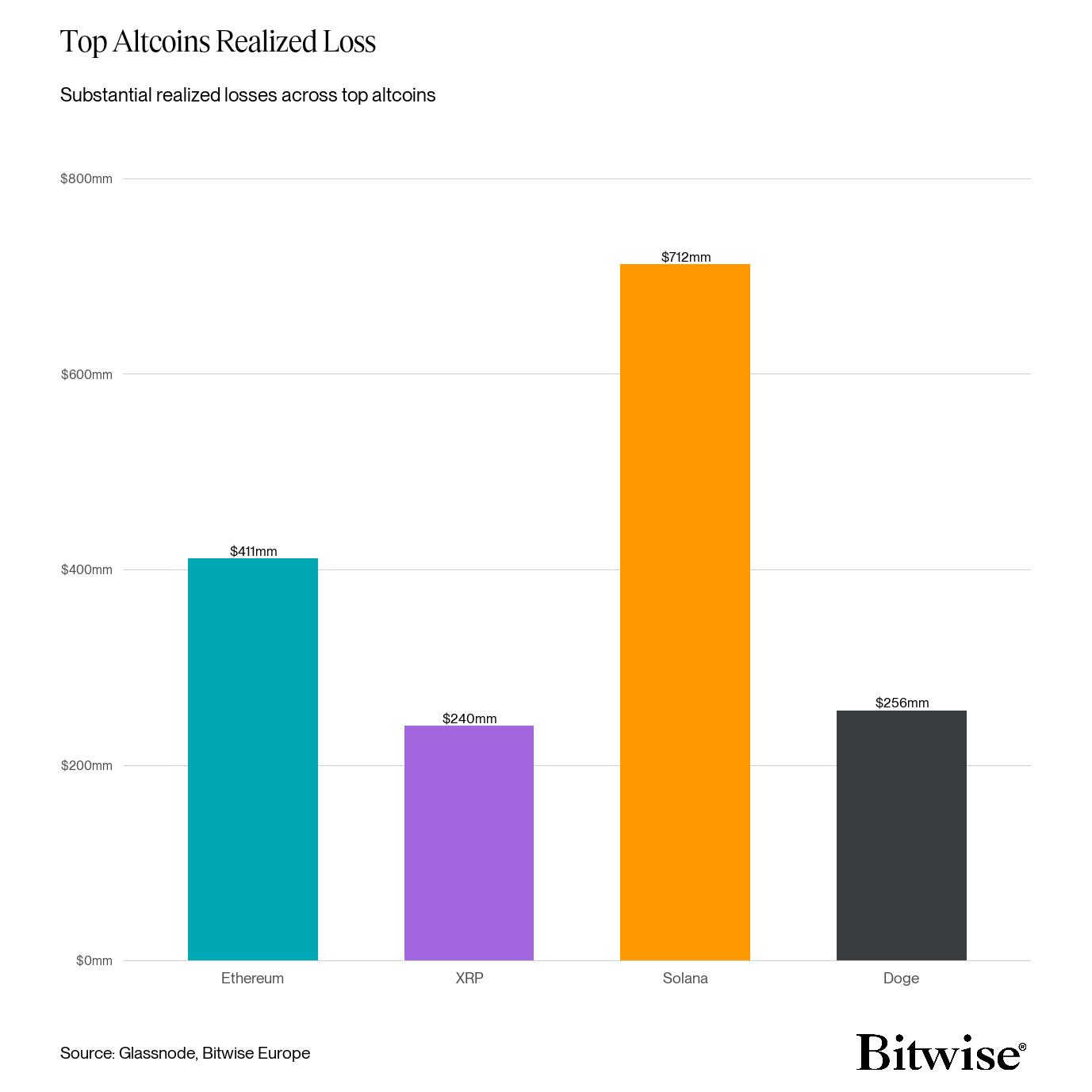
Increasing our granularity into the source of loss realization, we can examine the market through the lens of Long-Term Holders (LTHs), representing mature, conviction-driven investors, and Short-Term Holders (STHs), who typically reflect newer or more reactive market participants.
Notably, Short-Term Holders accounted for approximately 98% of all on-chain realized losses during the correction. This indicates that the majority of capitulation pressure originated from newer, more sentiment-sensitive investors, while Long-Term Holders largely remained passive, enduring the volatility without significant distribution.
Top Altcoins Short-Term Realized Loss Dominance
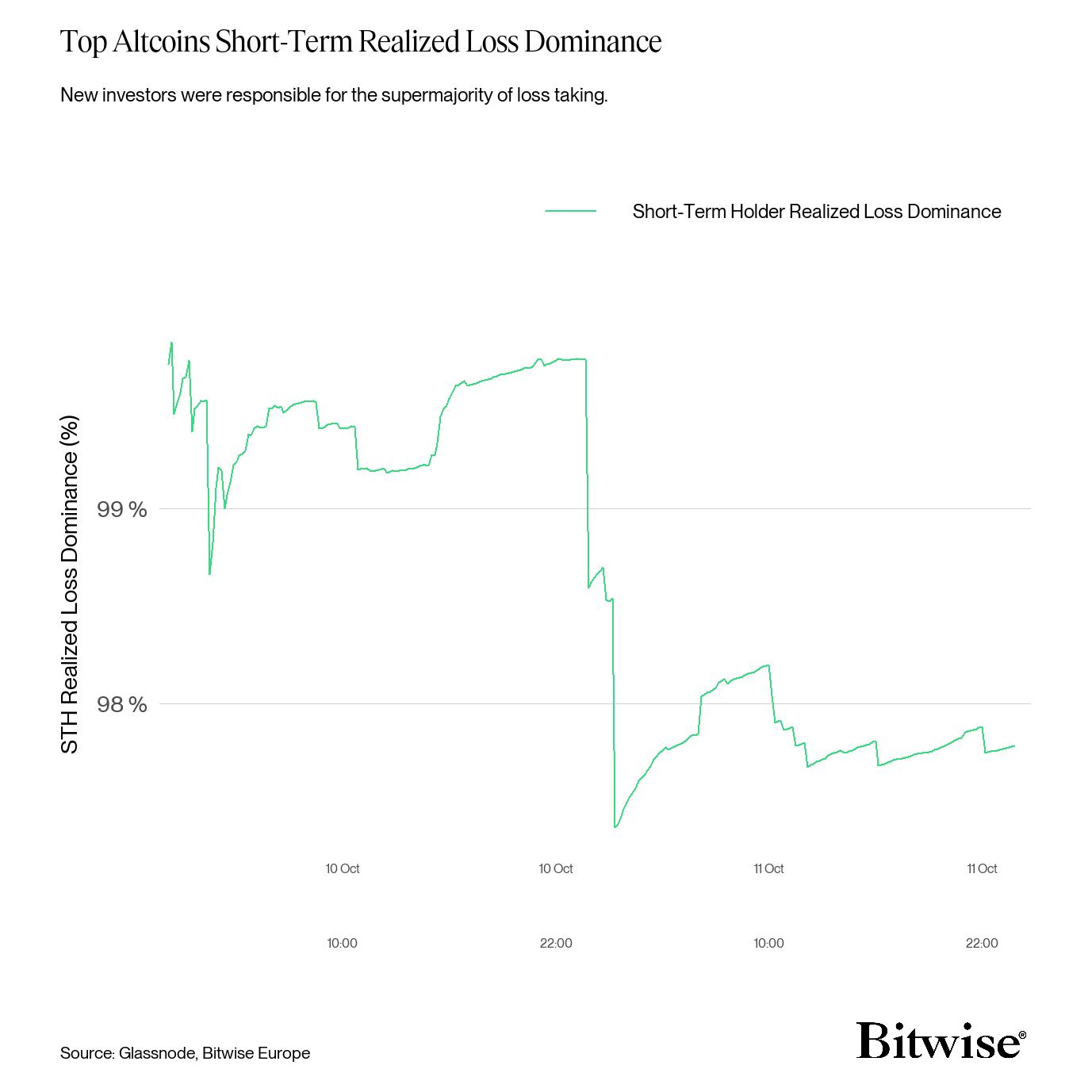
Additional granularity can be achieved by assessing the age distribution within the Short-Term Holder cohort, allowing us to identify whether selling pressure originated from the newest of market participants or from holders approaching Long-Term Holder classification.
- Ethereum Realized Losses (<1m): 93%
- XRP Realized Losses (<1m): 61%
- Solana Realized Losses (<1m): 97%
- Dogecoin Realized Losses (<1m): 78%
A closer examination of the loss distribution reveals that the majority of realized losses were concentrated within the front end of the Short-Term Holder cohort, primarily among investors with less than one month of holding time. This bolsters the notion that the recent correction was driven largely by newer, more price-sensitive participants capitulating under heightened volatility.
Age Cohort Dominance by Token
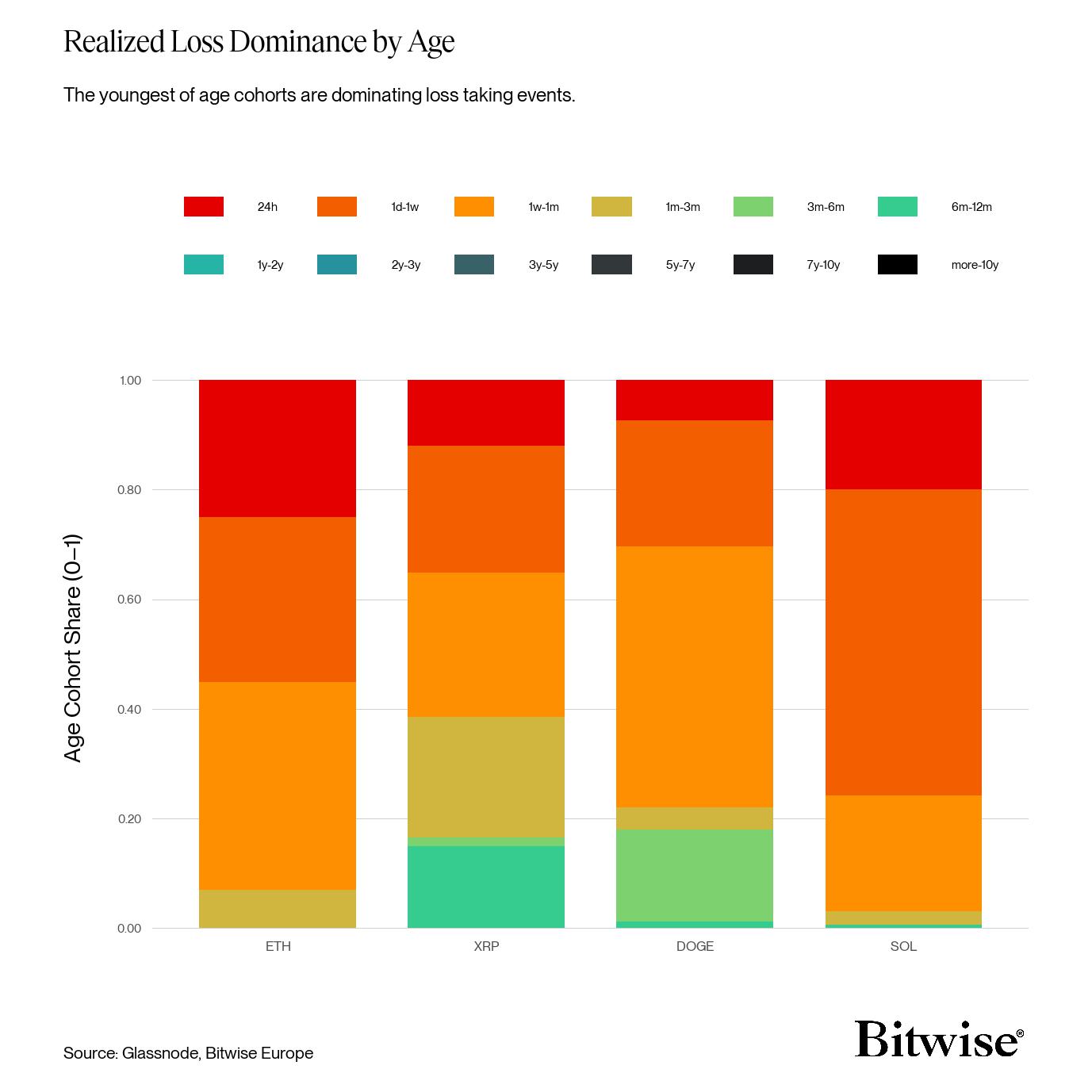
The Great Deleveraging
After evaluating the heightened scale of realized losses on-chain, we now turn to the derivatives markets to further dissect the mechanics of the sell-off and understand how leverage and futures positioning contributed to the event’s intensity.
Prior to sell-off, open interest across the top assets had reached an all-time high of $102bn, underscoring the build-up of speculation and euphoria that had been persistently growing across market investors, with many of such taking directional and leveraged views.
The subsequent downside price action triggered a sharp unwinding of futures positions, with open interest contracting by –$24.9B, the largest decline on record. This drawdown reflects a combination of forced liquidations and active position management, underscoring the fragility of markets heavily reliant on leveraged capital.
Interestingly, Bitcoin accounted for the lion's share of the open interest reduction, with an estimated $11bn in positions closed. Despite absorbing the largest nominal decline in derivative exposure, Bitcoin experienced the shallowest price drawdown among the major assets.
Top Assets Open Interest

Furthermore, when examining forced liquidations across major exchanges, the recent bout of volatility triggered a cascade of position closures, with liquidation spikes reaching $3.4bn across the major assets, marking the largest single event on record.
Expanding the scope to include a wider cohort of exchanges and assets, total liquidation volumes reached an estimated $19bn. For context, this represents a liquidation magnitude over 15x greater than that observed during the FTX capitulation of late 2021. Even so, this figure remains conservative given known limitations in exchange-level reporting, suggesting the true scale of liquidations was likely higher.
While the immediate outcome was one of acute deleveraging and disorderly position unwinds, a more constructive interpretation emerges in the aftermath. The substantial reduction in aggregate leverage and open interest may signal a healthy reset in investor sentiment after several months of heavily skewed upside expectations.
Top Asset Liquidations
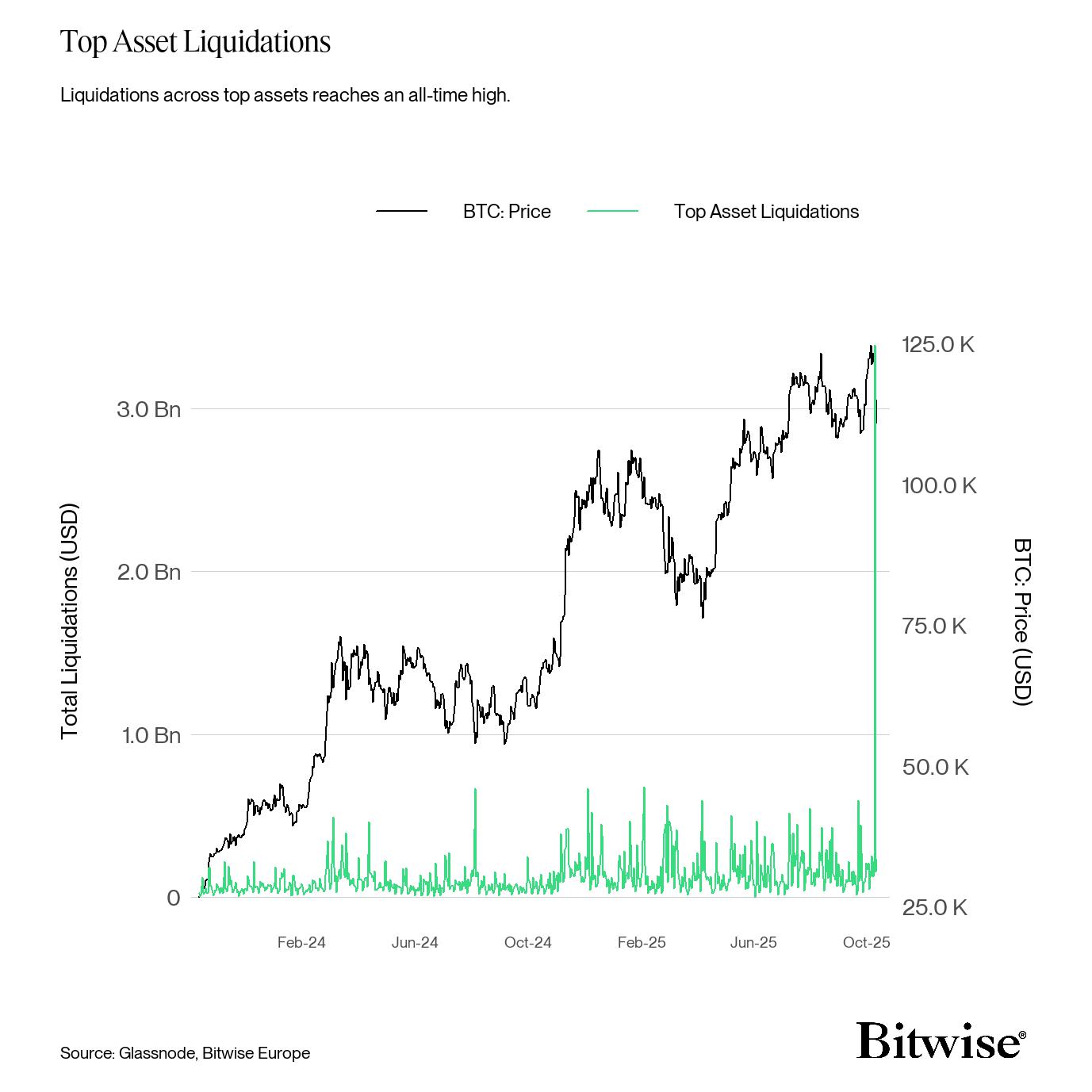
One lens we can utilise to quantify the market-wide reduction in leverage is through the Estimated Leverage Ratio, calculated as the ratio of open interest to the market capitalization of the underlying asset. Across the top digital assets, this metric recorded its largest single-day decline on record, reflecting the magnitude of position unwinding that accompanied the correction.
When viewed in conjunction with the steep reduction in open interest and the extraordinary liquidation volumes observed, this event can be characterized as the most significant deleveraging event in digital asset history. While on-chain data shows substantial realized losses, the evidence strongly suggests that the dominant driver of this drawdown originated within derivatives markets, where excessive leverage amplified the downside move and accelerated the sell-off's velocity.
Top Assets Leverage Ratio
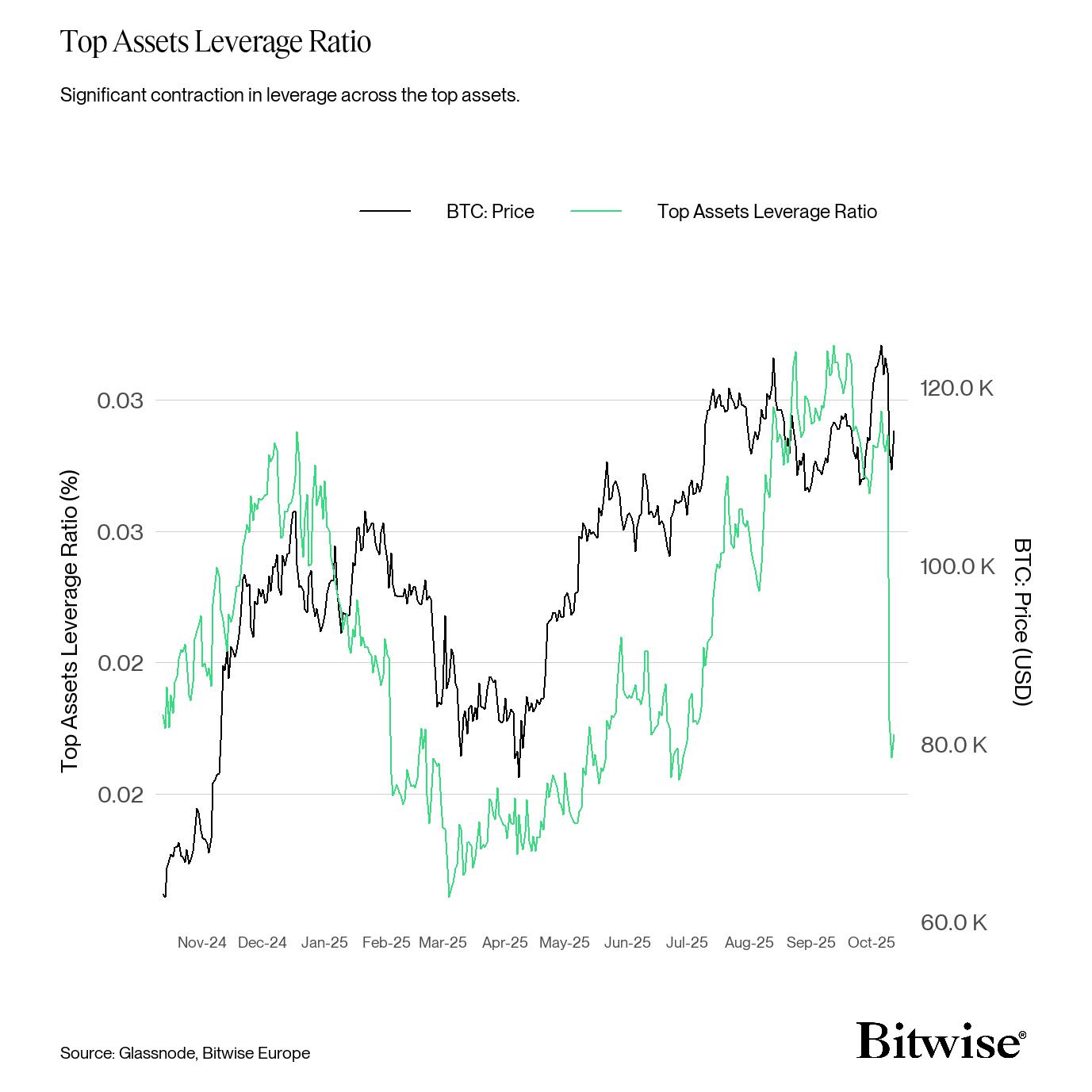
Bitcoin Paves the Way
As outlined throughout this analysis, Bitcoin has continued to demonstrate remarkable resilience throughout the recent correction, underscoring Bitcoin's current position as the primary driver of market structure and sentiment. As such, Bitcoin remains the key bellwether for assessing shifts in risk appetite and capital rotation across the digital asset landscape.
During the recent correction, Bitcoin price momentarily fell below the Short-Term Holder cost-basis ($114K) but quickly rebounded to reclaim this crucial level. Since this metric is often regarded as a boundary between local bull and bear market conditions, it's essential for the market to hold above this level to support continued recovery. Alternatively, a decisive loss of this level could result in an increase in sell-side pressure as unrealized losses begin to accelerate.
Short-Term Holder Cost-Basis
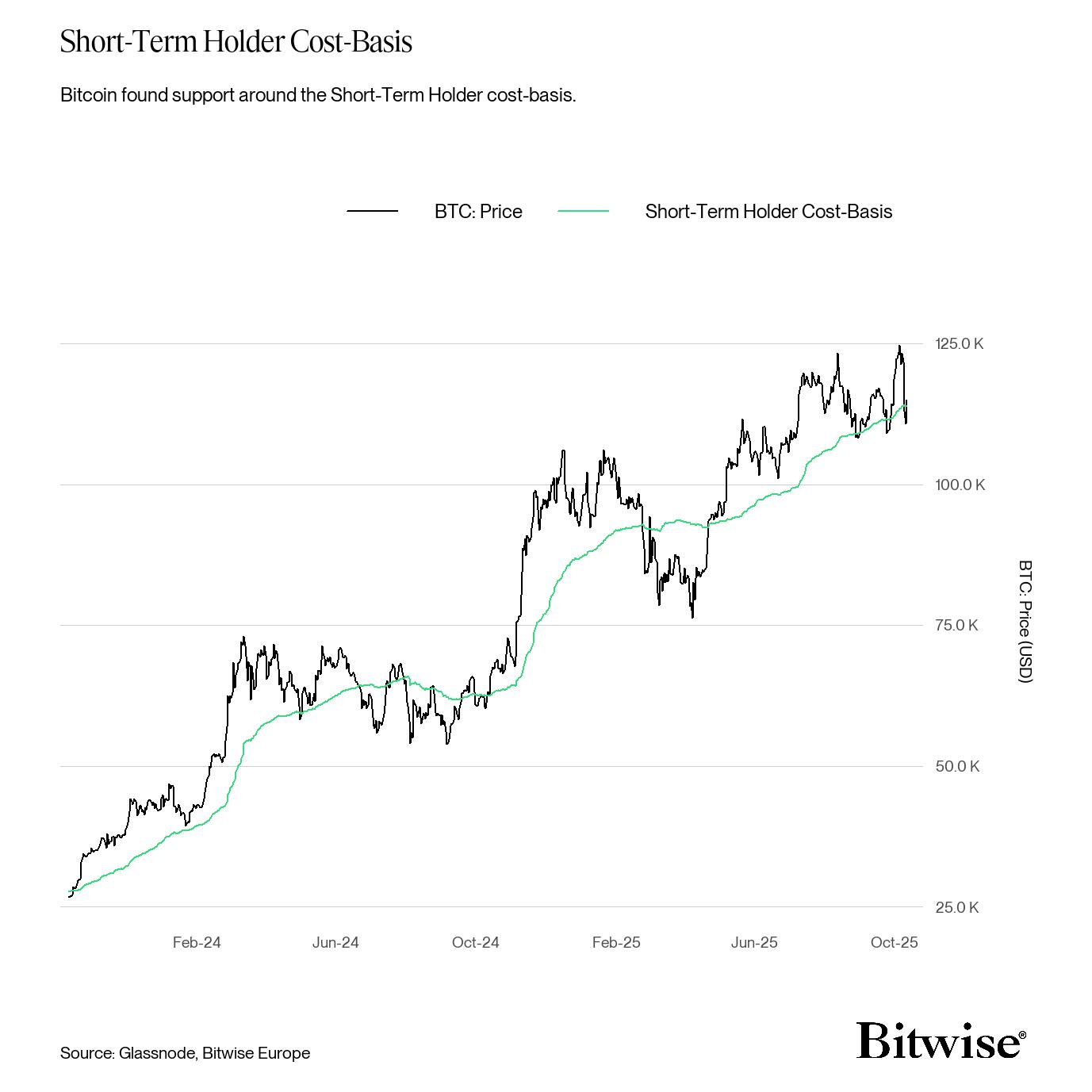
In addition, the Realized Supply Density metric suggests that market energy remains elevated, despite the sharp increase in volatility over the past week. This metric quantifies the share of supply held within a ±10% range of the current spot price. When a large portion of coins cluster around the spot level, even modest price moves can impact a wide group of holders, increasing market sensitivity and sustaining volatile conditions.
With a dense supply concentration still positioned near the spot price, the market appears primed for continued movement, suggesting that the recent bout of volatility may not yet have fully played out.
Realized Supply Density
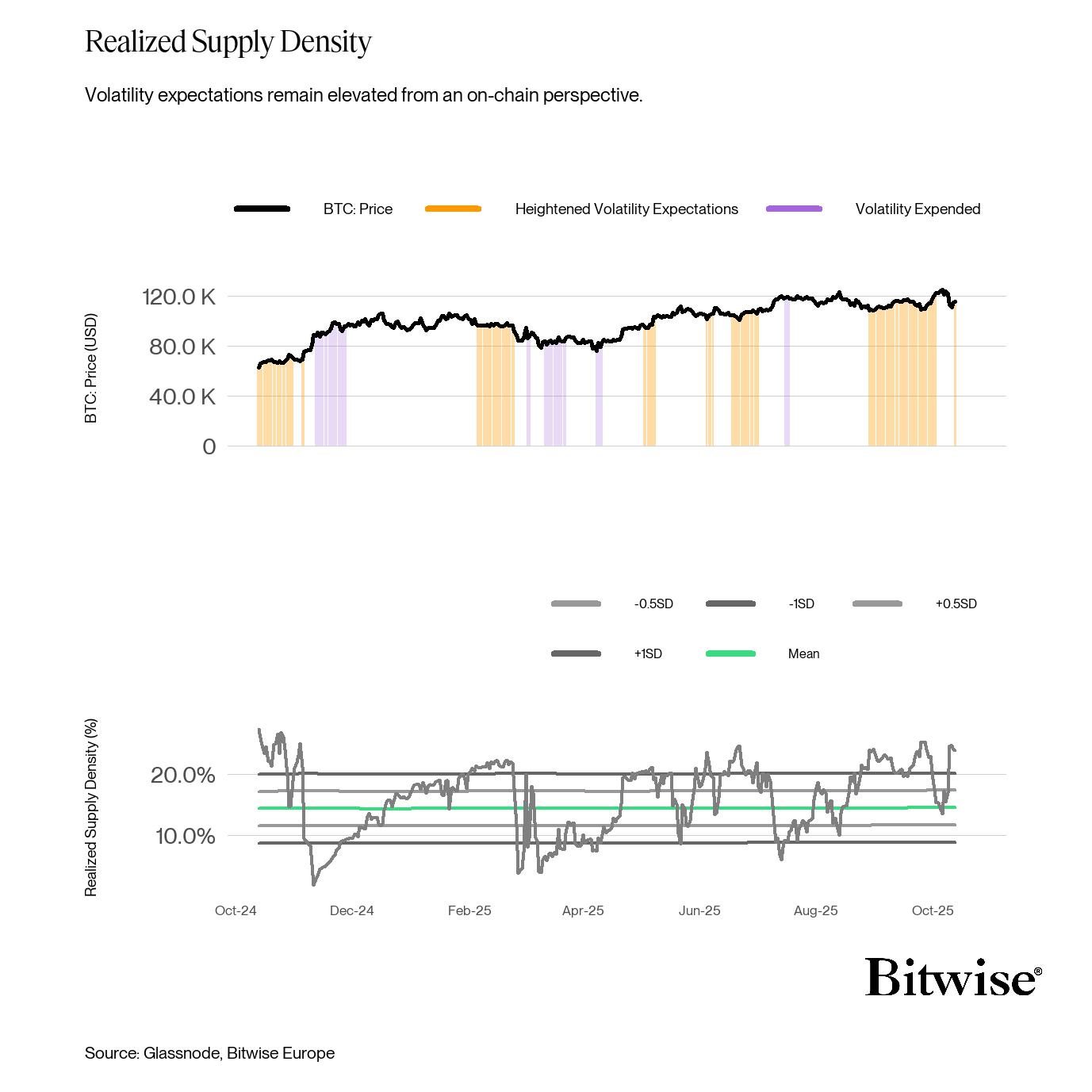
Summary and Conclusions
The recent market turmoil culminated in the largest deleveraging event in digital asset history, with an estimated $19 bn in liquidations across all assets, and a staggering $24.9 bn reduction in open interest across the top traded assets alone.
Altcoins absorbed the majority of the downside pressure, experiencing deep and disorderly drawdowns, while Bitcoin demonstrated notable resilience, recording a comparatively shallow correction despite accounting for the largest share of open interest closures.
A key takeaway from this signpost event is that the geopolitical landscape remains highly volatile, with the digital asset market showing strong sensitivity to major headlines. This dynamic leaves the market exposed to fresh shocks and abrupt shifts when macro conditions deteriorate or improve, an environment conducive to further market volatility.
Looking ahead, it is encouraging to observe Bitcoin defending its Short-Term Holder Cost Basis (STH-CB), which continues to act as a critical threshold for market structure. Sustaining this level could support renewed price appreciation and a recovery in investor confidence. Conversely, a decisive breakdown below this zone would likely signal renewed downside risk and a potential acceleration in unrealized losses, placing additional pressure on an already fragile market foundation.
Important information:
This article does not constitute investment advice, nor does it constitute an offer or solicitation to buy financial products. This article is for general informational purposes only, and there is no explicit or implicit assurance or guarantee regarding the fairness, accuracy, completeness, or correctness of this article or the opinions contained therein. It is advised not to rely on the fairness, accuracy, completeness, or correctness of this article or the opinions contained therein. Please note that this article is neither investment advice nor an offer or solicitation to acquire financial products or cryptocurrencies.
Before investing in crypto ETPs, potentional investors should consider the following:
Potential investors should seek independent advice and consider relevant information contained in the base prospectus and the final terms for the ETPs, especially the risk factors mentioned therein. The invested capital is at risk, and losses up to the amount invested are possible. The product is subject to inherent counterparty risk with respect to the issuer of the ETPs and may incur losses up to a total loss if the issuer fails to fulfill its contractual obligations. The legal structure of ETPs is equivalent to that of a debt security. ETPs are treated like other securities.

